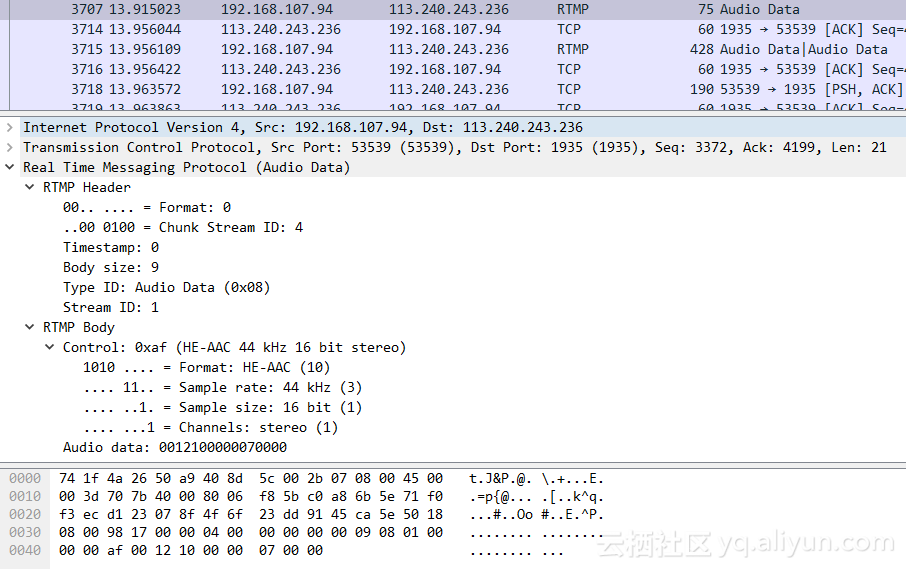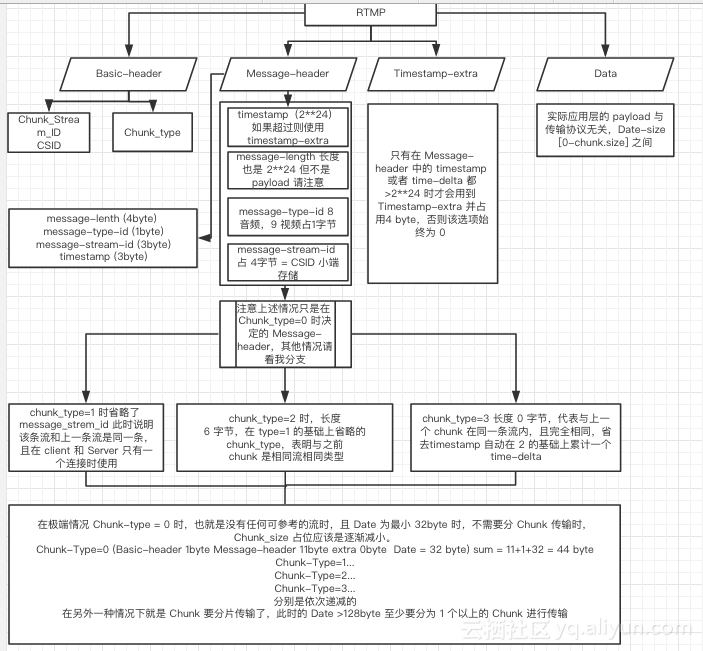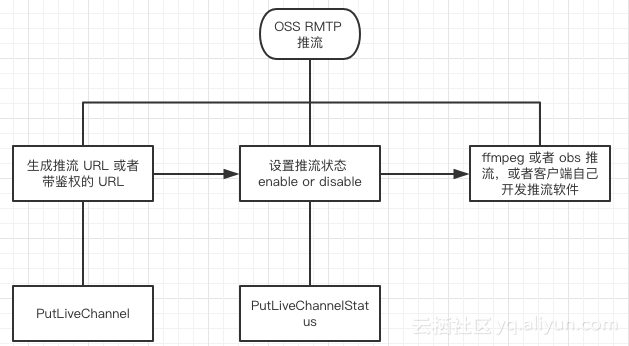OSS 直播功能深度分享
场景描述
目前有很多直播爱好者使用的是 OSS + RTMP 做的推流直播,其中不乏一些企业级别应用,由于 OSS 作为推流的接收略微有一些复杂,故单独开篇讲一下。其实不建议使用 OSS+RTMP 做直播推流,因为功能性相比专业的阿里云直播产品来说,OSS 的推流适合监管备份等特定场景 ,客户端对直播推流的延迟要求不是很敏感。如果对直播的拉流推流延迟有高敏感的场景,建议大家使用阿里云视频直播服务,可以做到上下行链路加速,且支持多样化的直播功能适配;
使用基础
简单的直播知识
您需要了解甚至掌握简单的直播知识技巧才能熟练的使用 OSS 直播,不仅是针对 OSS 还涉及到客户端的推流等相关问题,所以需要明白直播的相关基础
【音视频头介绍】
OSS 的直播功能是建立在 RTMP 直播传输协议的基础上,所以需要指导一些基础的 RMTP 知识:RTMP 的音视频流的封装形式和 FLV 格式相似, 流媒体服务器向客户端发送包含 H264 和 AAC 的 RTMP 直播流,需要首先发送这两个 header,没有这些信息播放端是无法解码音视频流的,其中音频 tag 格式如下
1)AVC sequence header
2)AAC sequence header
从上面推论出 AAC sequence header 内容的前 2 个字节是 0xAF 0x00,我们来看一个示例:
3)ADIF:Audio Data Interchange Format 音频数据交换格式。这种格式的特征是可以确定的找到这个音频数据的开始,不需进行在音频数据流中间开始的解码,即它的解码必须在明确定义的开始处进行。故这种格式常用在磁盘文件中。
4)ADTS:Audio Data Transport Stream 音频数据传输流。这种格式的特征是它是一个有同步字的比特流,解码可以在这个流中任何位置开始。它的特征类似于 mp3 数据流格式。
【RTMP 内容介绍】
以下是我对 RTMP 总结的一张完整描述图
对象存储推流架构
看下官网对于 OSS 推流的过程定义:
1)只能使用RTMP推流的方式,不支持拉流。
2)必须包含视频流,且视频流格式为H264。
3)音频流是可选的,并且只支持AAC格式,其他格式的音频流会被丢弃。
4)转储只支持HLS协议。
5)一个LiveChannel同时只能有一个客户端向其推流。
RTMP 的推流格式:
- demo :rtmp://your-bucket.oss-cn-hangzhou.aliyuncs.com/live/test-channel
- live 等同于 RTMP 的 APP 挂载点
- test-channel 等同于 RTMP 的 stream name
RTMP URL 推流签名:
- demo:rtmp://${bucket}.${host}/live/${channel}?OSSAccessKeyId=xxx&Expires=yyy&Signature=zzz&${params}
- 推流前 LiveChannel有两种Status:enabled和disabled,用户可以使用本接口在两种Status之间进行切换。处于disabled状态时,OSS会禁止用户向该LiveChannel进行推流操作;如果有用户正在向该LiveChannel推流,那么推流的客户端会被强制断开(可能会有10s左右的延迟)
对象存储推流的流程汇总图如下
使用 JAVA SDK 生成推流地址
我们现在用 java 的 SDK 演示一下如上的推理过程,在跑 SDK 之前,需要先搭建好一套本地的 eclipse 环境,如下是我用的 eclipse,如果有没搭建请网上搜索一下 eclipse 的搭建方式(之前需要安装 JDK 且配置环境变量)
环境要求
- Eclipse 版本:Version: Neon.3 Release (4.6.3)
- JDK 版本:jdk1.8.0_144
- OSS:公开读(为了验证推流功能是否正常,我们用公开读的方式快速测试)
- 我们采用主函数入口的方式,实例化其他类进行调用,这样方便类的拆分,不用都集合在主函数中。
- 主函数 domain,实例化 OSSClient 对象传入到 RtmpTest 类中测试。
- 所有的 jar 都会通过官方的 maven 解决的依赖关系,https://help.aliyun.com/document_detail/32009.html
package javasdk;
import java.io.FileNotFoundException;
import java.text.ParseException;
import java.util.HashMap;
import java.util.Map;
import com.aliyun.oss.OSSClient;
public class domain {
public static void main( String[] args ) throws ParseException, FileNotFoundException
{
System.out.println( "Hello World!" );
String accessid = "AK";
String secretkey = "SK";
String objectpath = "C://Users//hanli.zyb//Desktop//running.png";
String bucket = "bucket";
String object = "running";
String endpoint = "http://oss-cn-hangzhou.aliyuncs.com";
// OSS + rtmp 推流
String bucketName = "ali-hangzhou";
RtmpTest pushoss = new RtmpTest();
OSSClient ossClient = new OSSClient(endpoint, AK, SK);
pushoss.testCreateLiveChannel(bucketName,ossClient);
}
}
```
/*
- Licensed to the Apache Software Foundation (ASF) under one
- or more contributor license agreements. See the NOTICE file
- distributed with this work for additional information
- regarding copyright ownership. The ASF licenses this file
- to you under the Apache License, Version 2.0 (the
- "License"); you may not use this file except in compliance
- with the License. You may obtain a copy of the License at
* - http://www.apache.org/licenses/LICENSE-2.0
* - Unless required by applicable law or agreed to in writing,
- software distributed under the License is distributed on an
- "AS IS" BASIS, WITHOUT WARRANTIES OR CONDITIONS OF ANY
- KIND, either express or implied. See the License for the
- specific language governing permissions and limitations
- under the License.
*/
package javasdk;
import java.text.ParseException;
import java.util.Date;
import java.util.List;
import junit.framework.Assert;
import org.junit.Ignore;
import org.junit.Test;
import com.aliyun.oss.OSSClient;
import com.aliyun.oss.OSSErrorCode;
import com.aliyun.oss.OSSException;
import com.aliyun.oss.common.utils.DateUtil;
import com.aliyun.oss.model.CannedAccessControlList;
import com.aliyun.oss.model.CreateLiveChannelRequest;
import com.aliyun.oss.model.CreateLiveChannelResult;
import com.aliyun.oss.model.ListLiveChannelsRequest;
import com.aliyun.oss.model.LiveChannel;
import com.aliyun.oss.model.LiveChannelInfo;
import com.aliyun.oss.model.LiveChannelListing;
import com.aliyun.oss.model.LiveChannelStat;
import com.aliyun.oss.model.LiveChannelStatus;
import com.aliyun.oss.model.LiveChannelTarget;
import com.aliyun.oss.model.LiveRecord;
import com.aliyun.oss.model.PushflowStatus;
import com.aliyuncs.DefaultAcsClient;
import com.aliyuncs.profile.DefaultProfile;
import com.aliyuncs.profile.IClientProfile;
/**
- Test rtmp
*/
public class RtmpTest {
String bucketName = "bucket";
final String liveChannel = "stream name";
@Test
public void testCreateLiveChannelDefault(String bucketname,OSSClient ossClient) {
try {
CreateLiveChannelRequest createLiveChannelRequest = new CreateLiveChannelRequest(
bucketName, liveChannel);
CreateLiveChannelResult createLiveChannelResult = ossClient.createLiveChannel(createLiveChannelRequest);
LiveChannelInfo liveChannelInfo = ossClient.getLiveChannelInfo(bucketName, liveChannel);
ossClient.deleteLiveChannel(bucketName, liveChannel);
} catch (Exception e) {
Assert.fail(e.getMessage());
}
}
@Test
public void testCreateLiveChannel(String bucketname,OSSClient ossClient) {
final String liveChannel = "normal-create-live-channel";
final String liveChannelDesc = "my test live channel";
try {
LiveChannelTarget target = new LiveChannelTarget("HLS", 100, 99, "myplaylist.m3u8");
CreateLiveChannelRequest createLiveChannelRequest = new CreateLiveChannelRequest(
bucketName, liveChannel, liveChannelDesc, LiveChannelStatus.Enabled, target);
CreateLiveChannelResult createLiveChannelResult = ossClient.createLiveChannel(createLiveChannelRequest);
System.out.println(createLiveChannelResult.getPublishUrls());
/*Assert.assertEquals(createLiveChannelResult.getPublishUrls().size(), 1);
Assert.assertTrue(createLiveChannelResult.getPublishUrls().get(0).startsWith("rtmp://"));
Assert.assertTrue(createLiveChannelResult.getPublishUrls().get(0).endsWith("live/" + liveChannel));
Assert.assertEquals(createLiveChannelResult.getPlayUrls().size(), 1);
Assert.assertTrue(createLiveChannelResult.getPlayUrls().get(0).startsWith("http://"));
Assert.assertTrue(createLiveChannelResult.getPlayUrls().get(0).endsWith(liveChannel + "/myplaylist.m3u8"));*/
/* LiveChannelInfo liveChannelInfo = ossClient.getLiveChannelInfo(bucketName, liveChannel);
Assert.assertEquals(liveChannelInfo.getDescription(), liveChannelDesc);
Assert.assertEquals(liveChannelInfo.getStatus(), LiveChannelStatus.Disabled);
Assert.assertEquals(liveChannelInfo.getTarget().getType(), "HLS");
Assert.assertEquals(liveChannelInfo.getTarget().getFragDuration(), 100);
Assert.assertEquals(liveChannelInfo.getTarget().getFragCount(), 99);
Assert.assertEquals(liveChannelInfo.getTarget().getPlaylistName(), "myplaylist.m3u8");*/
// ossClient.deleteLiveChannel(bucketName, liveChannel);
} catch (Exception e) {
Assert.fail(e.getMessage());
}
}}
其中我们最关注的是 testCreateLiveChannel 类,创建了推流地址,其中参数 LiveChannelStatus.enable 是要让推流变为可用状态。
running 主函数,打印出推流地址。
rtmp://hangzhou.oss-cn-hangzhou.aliyuncs.com/live/normal-create-live-channel
public void testCreateLiveChannel(String bucketname,OSSClient ossClient) {
final String liveChannel = "normal-create-live-channel";
final String liveChannelDesc = "my test live channel";
try {
LiveChannelTarget target = new LiveChannelTarget("HLS", 100, 99, "myplaylist.m3u8");
CreateLiveChannelRequest createLiveChannelRequest = new CreateLiveChannelRequest(
bucketName, liveChannel, liveChannelDesc, LiveChannelStatus.Enabled, target);
CreateLiveChannelResult createLiveChannelResult = ossClient.createLiveChannel(createLiveChannelRequest);
System.out.println(createLiveChannelResult.getPublishUrls());
/*Assert.assertEquals(createLiveChannelResult.getPublishUrls().size(), 1);
Assert.assertTrue(createLiveChannelResult.getPublishUrls().get(0).startsWith("rtmp://"));
Assert.assertTrue(createLiveChannelResult.getPublishUrls().get(0).endsWith("live/" + liveChannel));
Assert.assertEquals(createLiveChannelResult.getPlayUrls().size(), 1);
Assert.assertTrue(createLiveChannelResult.getPlayUrls().get(0).startsWith("http://"));
Assert.assertTrue(createLiveChannelResult.getPlayUrls().get(0).endsWith(liveChannel + "/myplaylist.m3u8"));*/
// ossClient.deleteLiveChannel(bucketName, liveChannel);
} catch (Exception e) {
Assert.fail(e.getMessage());
}
}







